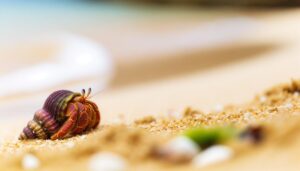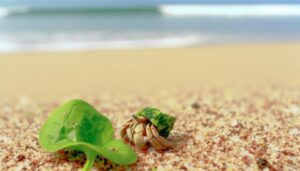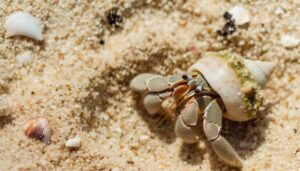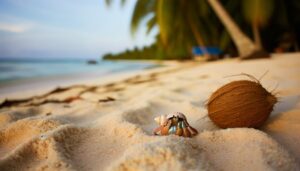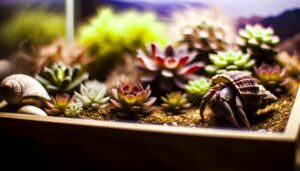How Do Hermit Crabs Need Water to Swim?
Hermit crabs need both freshwater and saltwater to thrive. Freshwater is crucial for maintaining osmotic balance and hydration, while saltwater supports molting, respiration, and shell maintenance.
Make sure you use dechlorinated freshwater and mix saltwater to approximately 35 ppt salinity. Monitor humidity levels, ideally between 70-80%, to prevent dehydration, which can cause lethargy and a dry exoskeleton.
Regularly check water quality, including salinity, pH, and temperature, to promote metabolic processes and overall health. Proper water management is vital for their natural behaviors and longevity—keep exploring the intricacies of their hydration needs.
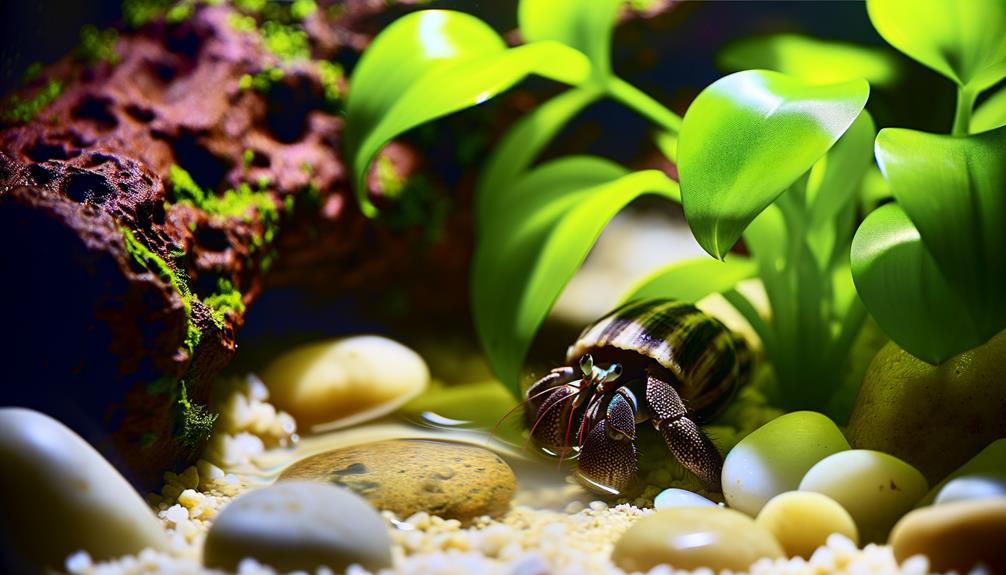
Key Takeaways
- Hermit crabs require both freshwater and saltwater for hydration and physiological functions.
- Freshwater helps maintain osmotic balance and proper hydration for metabolic processes.
- Saltwater is essential for molting, respiration, and shell maintenance.
- Regular access to clean, dechlorinated water sources is crucial for their health.
- Maintaining ideal humidity levels (70-80%) ensures their well-being and activity.
Importance of Water
Water plays an essential role in maintaining the physiological functions and overall health of hermit crabs. You'll find that hydration is necessary for hemolymph circulation, aiding in the transportation of nutrients and oxygen.
Moreover, proper hydration supports metabolic processes, including excretion and digestion. Without sufficient water, hermit crabs can't efficiently regulate their body temperature, leading to thermal stress. Dehydration can cause lethargy, reduced molting frequency, and even mortality.
Data indicates that hermit crabs require a specific humidity range, typically between 70-80%, to thrive. Ensuring they've access to water helps maintain this ideal environment. By understanding these needs, you can better serve the welfare of these creatures, promoting their longevity and well-being.
Types of Water Needed
Hermit crabs need both freshwater and saltwater to meet their diverse physiological needs and maintain peak health. Freshwater is essential for hydration and helps regulate internal osmotic balance. Saltwater, on the other hand, is vital for proper gill function and molting processes.
Scientific studies indicate that a dual water system guarantees optimal metabolic activity and reduces stress markers. Use dechlorinated freshwater and marine-grade salt for saltwater to mimic natural habitats.
Regularly test water quality to maintain parameters such as salinity (30-35 ppt for saltwater) and pH (7.5-8.5). By providing these specific water types, you'll support the hermit crabs' complex biological functions, thereby enhancing their longevity and overall well-being.
Freshwater Requirements
Securing access to dechlorinated freshwater is crucial for maintaining the osmotic balance and overall hydration of hermit crabs. Freshwater, free from chlorine and heavy metals, supports their excretory functions by facilitating ion exchange and maintaining intracellular fluid balance.
Studies indicate that hermit crabs exhibit increased activity levels when provided with ideal hydration sources, validating the importance of freshwater in their captive environment.
You should use a water conditioning agent to eliminate harmful substances from tap water. Maintain a shallow dish with easy access to prevent drowning. Regularly monitor and replace the water to optimize its purity.
Saltwater Needs
In addition to freshwater, hermit crabs require access to saltwater to facilitate proper molting, respiration, and shell maintenance. Studies indicate that hermit crabs use saltwater to balance osmotic pressure, essential for their physiological functions.
When preparing saltwater, make sure the salinity mirrors natural seawater, typically around 35 parts per thousand (ppt). Utilize marine salt mix rather than table salt, to avoid harmful additives.
Hermit crabs often prefer pools of saltwater for submersion, aiding in the hydration of gills and exoskeleton. Regular access to saltwater also supports the molting process, allowing for successful exoskeleton shedding and regeneration.
Water Quality
Maintaining top-notch water quality is crucial for the health and physiological functions of hermit crabs, requiring regular monitoring and adjustments. You should measure salinity, pH levels, and temperature consistently.
Ideal salinity ranges between 1.020 and 1.025 specific gravity, while the pH should stay between 8.0 and 8.3. Temperature needs to be maintained around 72-78°F. Use dechlorinated water to avoid harmful chlorine or chloramine exposure.
Regularly test water parameters using reliable kits to ensure prime conditions. Implement water changes weekly, replacing 10-20% of the water to maintain quality. Filter systems can aid in maintaining purity, but they don't replace the necessity of manual checks and balances.
Keeping these parameters stable ensures hermit crabs thrive, supporting their exoskeleton formation and molting processes.
Water Sources
While maintaining ideal water quality is pivotal, understanding the different water sources available for your hermit crabs is equally important. Hermit crabs require both fresh and saltwater to thrive. Freshwater should be dechlorinated, using either chemical dechlorinators or by letting the water sit for 24 hours.
Saltwater must mimic natural seawater conditions, achieved by mixing marine salt with dechlorinated water until it reaches a specific gravity of 1.021-1.026, as measured by a hydrometer.
You can use tap water if dechlorinated properly. However, distilled or bottled water can be more consistent in quality. Regularly test water parameters like pH, salinity, and chlorine levels to ensure optimal conditions.
Amount of Water
To maximize hydration and environmental conditions, provide hermit crabs with shallow dishes of both fresh and saltwater, allowing them to submerge without risk of drowning. Maintain water levels at a depth of 1-2 inches, ensuring accessibility for crabs of all sizes.
This dual-source hydration method supports osmoregulation, as hermit crabs require both types of water for peak physiological function. Scientific evidence indicates that maintaining relative humidity levels between 70-80% in the habitat enhances hydration and reduces stress.
Implement regular water changes every 2-3 days to prevent bacterial growth and maintain water quality. By meticulously managing these parameters, you'll create a thriving environment, promoting the well-being and longevity of hermit crabs under your care.
Water Dish Setup
Start by selecting non-metallic, shallow water dishes to prevent contamination and make certain hermit crabs can easily access both fresh and saltwater without risk of tipping or drowning.
Utilize ceramic or plastic materials, guaranteeing the dish diameter is sufficient for the crabs to enter. Place the freshwater dish on one side of the habitat and the saltwater dish on the opposite side to replicate their natural environment.
Ensure a depth of approximately 1-2 inches, facilitating hydration and gill function. Incorporate natural rock or coral pieces in the dish to assist climbing and prevent accidental drowning.
Maintain a minimum of two water sources to allow natural behaviors and support osmotic regulation critical to hermit crab health.
Maintaining Water Cleanliness
Regularly check and replace the water in the dishes to prevent bacterial growth and maintain peak health conditions for your hermit crabs. Utilize dechlorinated or marine saltwater, maintaining a consistent pH between 7.5 and 8.4, which mimics their natural habitat.
Replace water daily, as stagnant water can harbor pathogens like Pseudomonas and Aeromonas species, which may compromise shell health and overall essentiality.
Employ a hygrometer to measure humidity levels, aiming for 70-80% to support proper respiration and hydration.
Clean dishes thoroughly with a gentle, hermit-crab-safe disinfectant weekly to eliminate biofilm and residue.
Hydration and Molting
Maintaining sufficient hydration is vital during molting, as hermit crabs depend on water to aid the shedding process and regain strength. During ecdysis, their exoskeletons soften, requiring optimal hydration levels.
You should monitor the salinity and quality of both fresh and marine water sources within their habitat. Research indicates that hermit crabs showing dehydration often undergo delayed or incomplete molting, leading to mortality rates exceeding 50%.
To prevent this, maintain humidity levels between 70-80% and provide consistent access to dechlorinated water. Utilize hygrometers to ensure environmental stability.
Water and Shell Selection
Choosing the right shell is crucial for a hermit crab's health, and access to water greatly influences this process. Proper hydration allows hermit crabs to move in and out of shells more easily, ensuring they can select the best one for their size and needs. Dehydrated crabs struggle with this, leading to poor shell choices and increased vulnerability.
Here's a breakdown of how water impacts shell selection:
| Factor | Hydrated Crabs | Dehydrated Crabs |
|---|---|---|
| Shell Mobility | High | Low |
| Shell Selection Rate | Best | Suboptimal |
| Vulnerability | Low | High |
| Health Implications | Positive | Negative |
Signs of Dehydration
Dehydrated hermit crabs often exhibit lethargy, a lack of appetite, and a dry exoskeleton, indicating they aren't getting the necessary hydration. You'll notice they move less and may retreat into their shells more frequently.
A scientific study shows that hermit crabs need access to both fresh and saltwater to maintain osmotic balance, essential for cellular function. Monitor their water sources; dehydration can lead to severe complications like molting issues and even mortality.
Assess their exoskeleton texture: a hydrated crab's exoskeleton should appear slightly moist and flexible. Use a hygrometer to maintain ideal humidity levels between 70-80%, as proper humidity aids in hydration.
Providing consistent water sources is crucial for their overall well-being.
Common Water Mistakes
You might make critical errors such as providing insufficient hydration sources, introducing contaminated water, or using the incorrect water type. Research indicates that hermit crabs require both freshwater and saltwater for peak health.
Contaminated water can lead to bacterial infections, while incorrect water type can disrupt their osmoregulation processes.
Insufficient Hydration Sources
Many hermit crab owners inadvertently compromise their pets' health by neglecting to provide both freshwater and saltwater in appropriate quantities. This oversight can lead to dehydration, osmoregulatory imbalance, and even mortality. To ensure maximum hydration:
- Dual Bowl System: Use separate containers for freshwater and saltwater to maintain proper hydration and electrolyte balance.
- Proper Depth: Guarantee water bowls are deep enough for complete submersion but easy to exit, promoting natural bathing and hydration behaviors.
- Water Quality: Regularly change water to prevent microbial contamination, even though this doesn't pertain to the next subtopic.
- Saltwater Composition: Utilize marine-grade salt mix to replicate natural ocean conditions, which is essential for physiological processes.
Implementing these steps enhances your hermit crabs' wellbeing and longevity.
Contaminated Water Risks
Contaminated water poses significant health risks to hermit crabs, including bacterial infections and chemical toxicity. When you provide water, make sure it's free from harmful pathogens such as Pseudomonas and Vibrio, which can cause severe infections.
Use a water conditioner to neutralize chlorine and chloramine, common in tap water, which are toxic to hermit crabs. Regularly test water parameters, aiming for a pH between 7.5 and 8.4, to prevent acidic or alkaline imbalances.
Replace water at least twice a week to avoid buildup of waste and contaminants. By maintaining clean water conditions, you're directly contributing to the hermit crabs' overall health and well-being, ensuring they thrive in a safe environment.
Incorrect Water Type
Choosing the incorrect type of water can lead to significant health issues for hermit crabs, as their physiological needs require specific water parameters. Freshwater and marine environments require unique water types. You must avoid common mistakes to ensure ideal care:
- Tap Water: Contains chlorine and heavy metals harmful to hermit crabs. Always dechlorinate before use.
- Distilled Water: Lacks essential minerals, causing osmotic imbalance.
- Softened Water: High sodium levels can be detrimental to their health.
- Unfiltered Saltwater: Use marine salt mix instead of table salt to replicate natural seawater composition.
Conclusion
Ensuring your hermit crabs have the right water is essential for their well-being. They need both freshwater and saltwater, meticulously maintained for best quality. Proper hydration supports their molting process and influences shell choices, while dehydration can lead to unfortunate outcomes.
Avoid common water mistakes by providing balanced hydration to keep your crustacean friends thriving. Remember, their aquatic needs aren't just about survival—they're necessary for their overall health and happiness.

